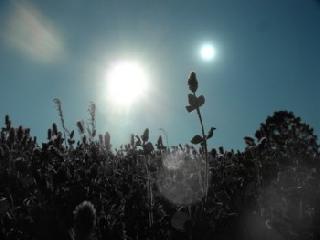
LONDON (BNS): An Earth-like planet revolving around two or more Sun-like stars may be the breeding ground for black vegetation, a new study has found.
While our Earth harbours plants and trees with the colour green, an exoplanet with multiple Suns could grow black or grey vegetation, according to Jack O'Malley-James of the University of St Andrews.
Photosynthesis – the process of converting sunlight into energy and the basis for majority of life on Earth – determines the colour of plants and trees on a planet.
“If a planet were found in a system with two or more stars, there would potentially be multiple sources of energy available to drive photosynthesis.
“The temperature of a star determines its colour and, hence, the colour of light used for photosynthesis. Depending on the colours of their star-light, plants would evolve very differently,” says O'Malley-James who has studied what plants might be like on an Earth-like planet with two or three Suns.
The author presented his paper at the Royal Astronomical Society’s National Astronomy Meeting in Llandudno on Tuesday.
The researcher and his team analysed the potential for photosynthetic life in multi-star systems with different combinations of Sun-like stars and red dwarfs.
Sun-like stars are known to host exoplanets and red dwarfs are the most common type of star in our Milky Way galaxy, often found in multi-star systems, and old and stable enough for life to have evolved. Over 25% of Sun-like stars and 50% of red dwarfs are found in multi-star systems.
In the team’s simulations, the Earth-like planets either orbit two stars close together or orbit one of two widely separated stars. The team has also looked at combinations of these scenarios, with two close stars and one more distant star.
“Our simulations suggest that planets in multi-star systems may host exotic forms of the more familiar plants we see on Earth,” the researcher said.
“Plants with dim red dwarf suns for example, may appear black to our eyes, absorbing across the entire visible wavelength range in order to use as much of the available light as possible,” he said.
Some of them may also be able to use infrared or ultraviolet radiation for the photosynthesis process.
“For planets orbiting two stars like our own, harmful radiation from intense stellar flares could lead to plants that develop their own UV-blocking sun-screens, or photosynthesising microorganisms that can move in response to a sudden flare,” O'Malley-James said.
 Previous Article
Previous Article Next Article
Next Article












The Indian Air Force, in its flight trials evaluation report submitted before the Defence Ministry l..
view articleAn insight into the Medium Multi-Role Combat Aircraft competition...
view articleSky enthusiasts can now spot the International Space Station (ISS) commanded by Indian-American astr..
view article